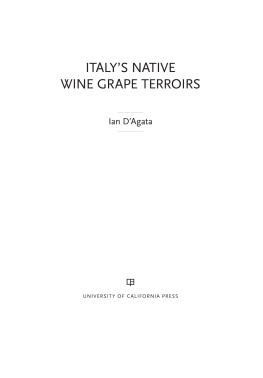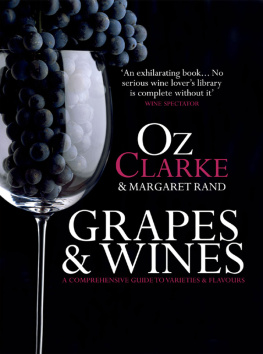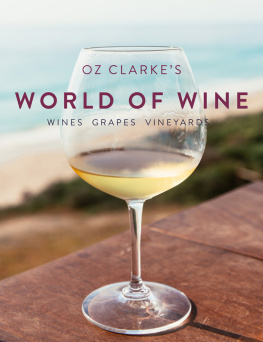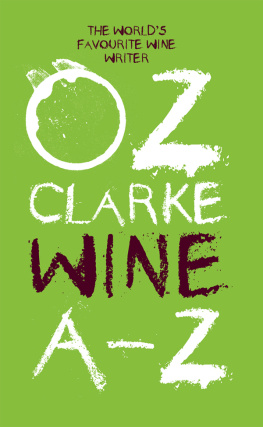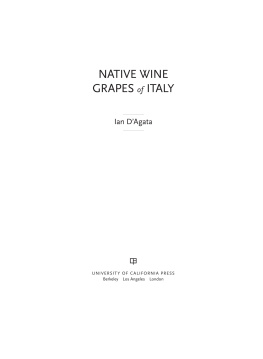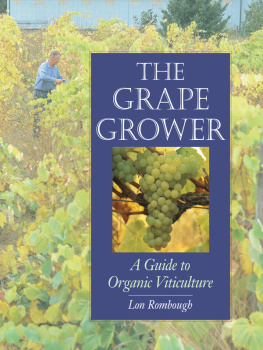More than anything, this ones for you, Mom and Dad.
Contents
When people ask me how I got into wine, my answer is always the same: Very, very reluctantly.
Its not that I didnt love wine, or that I found it boring, or that I thought of it as just another alcoholic drink; quite the opposite. The problem is its almost too interesting, too complex, too broad. Why, its even got its own unique language. And then theres the science-y component, the geographical knowledge required, and the fact that its subjective and constantly evolving. I mean, someone pour me a glass of wine so I can process all this stuff that I have to learn about wine! To cut a long story short, I started out feeling like you probably do about the subject: completely overwhelmed and totally unsure of where to begin.
For me, the easiest, most logical starting point was grapes, and so that is the focus of this book. The following pages will outline the worlds major red and white varietals and give you a snapshot of what you need to know about them to embark on a more informed wine-drinking journey. Basics like notable growing regions and food pairings are covered with each, as well as more practical things for consumers such as general tasting descriptors to help you convey what you like or dont (the Key Words) and examples of other grapes you might like.
Supporting this core information are nuggets of the most useful, practical tips you might need: the dos and donts of storing and serving, FAQs about ros, how to understand key wine descriptors through side-by-side tastings, a cheat sheet on deciphering labels, a whirlwind tour of the world of sparkling wine and a glossary of technical and sommelier terms.
Dont see this as your complete guide to everything wine-related but, rather, your friendly (pocket-sized!) overview of the essentials. So, please, drink up, and remember to have fun and keep learning.
Front
Producer Name
Often the easiest item to pick out on a label as it tends to be the most prominent, this is the name of who made the wine. In France, look for the prefix Domaine or Chteau; in Germany and Austria, Weingut; in Italy, Castello, Cantina or Tenuta; Quinta in Portuguese and, in Spanish-speaking countries, Bodegas. Sometimes also a wine may go by a branded name that is a subsidiary of a large-scale producer (most often youll see this with a New World wine, the US especially).
Vintage
The year the grapes were harvested.
Region/Appellation/Sub-Appellation/Vineyard Name
When it comes to wines from the EU, the broad strokes perspective is that the more specific the growing site listed, the higher quality the wine is going to be. Its like a hospital consultant with a lot of letters after their name: it means theyve had to pass more tests and meet more standards, and are therefore more unique and prized because of it.
Regional Classification
For example, Appellation dOrigine Contrle (AOC) in France; Indicazione Geografica Tipica (IGT), Denominazione di Origine Controllata (DOC) and Denominazione di Origine Controllata e Garantita (DOCG) in Italy; Denominacin de Origen (DO/DOC) in Spain; Districtus Austriae Controllatus (DAC) in Austria; Denominao de Origem Controlada (DOC) in Portugal and American Viticultural Area (AVA) in the US. These regulatory bodies determine the rules and regulations for the regions growing practices and standards.
Vineyard Site Quality Level Indicator
In France, look for words like Premier Cru and the even more prized Grand Cru; in Germany, keep an eye out for either VDP Grosse Lage or VDP Grosses Gewachs, but you should also expect to pay a lot more for these wines. Just remember: not all regions even some of the top ones, like Barolo have a built-in quality classification hierarchy for their vineyard sites, so be careful not to look for one as an absolute, across-the-board prerequisite.
Aging Indicator
In the EU, the word Reserve (aka Riserva/Reserva/Gran Reserva) indicates that the wine has been aged for a period of time prior to release. The amount of time depends on the regions particular regulated standards. Again, expect these to be more expensive. Important side note though: the term is not protected in New World regions like the U.S. and Australia.
Sweetness Level Indicator
Most commonly seen on bottles of German Riesling, which can range from dry (Trocken) to off-dry (Kabinett) to sweet (Sptlese) to very sweet (Auslese) (just an FYI: Technically, those last three terms refer to the ripeness level of the grapes at harvest time, but by and large it will coordinate with the sweetness level of the wine). These will appear as a suffix to the grape varietal. Another good example would be on labels of Chenin Blanc from Vouvray, which will tell you the wine is off-dry with the words Demi-sec or sweet with the word Moelleux.
Grape Varietal
This is more common practice with New World wines and wines from Austria and Germany, although it is becoming more prevalent throughout Old World regions. This is the grape that makes up the overwhelming majority, if not 100%, of the wine.
Bottle Size
Measured in millilitres, the standard bottle size is 750 ml (25.4 fl oz). Half bottles come in 375 ml (12.7 fl oz) bottles, while magnums are double the standard size at 1.5 l (50.8 fl oz).
ABV
Literally, the Alcohol by Volume. Most dry red and white wines fall in the 1213.5% range. Lower than 12% in a white and you can expect it to be a little sweet, and reds clocking in at over 14% are likely to be full, rich and boozy.
Back
Importer and/or Distributor
The company responsible for sourcing and shipping the wine from its country of origin and distributing it for sale in its current location. Essentially, the wines talent agent.
Government Warning
Most countries include a government-mandated warning, either via symbol or text, indicating that consuming alcohol impairs your ability to drive, is not advised for pregnant women, and may be detrimental to your health.
Product of [Country Name]
Estate Bottled
As straightforward as it sounds, this means the wine was bottled by the producer at the winery where it was made. For French wines, you might alternatively see



